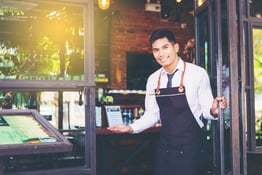Optimization has been one of the main themes in the restaurant industry during the Covid-19 pandemic. With fewer resources available (opening hours, tables, diners, staff, etc.), restaurants started to use apps to speed up ordering and payment, and simplified menus, only keeping best sellers and guest favorites.
The importance of efficiency is going to have a permanent place in the post-Covid world too. That should extend beyond menus, though, and embrace the whole customer experience from beginning to end.
In this blog post we’re going to explain what that means and why technology is the best way to do it.

The outdated approach
One of the universal laws of business says that it's much more cost-effective to keep existing customers than find new ones. Unfortunately, many restaurants are not proactive about this goal. They are stuck in the loop of getting as many new diners as possible through the door, hoping they leave happy enough to come back and recommend them to others.
This outdated in-and-out type of approach is based on the common fallacy that a restaurant lives and dies by the quality of its food and service. While that certainly works for some, it could be detrimental to many businesses.
In the post-pandemic normality, restaurants have a new competitor: living rooms. During lockdowns and closures, diners discovered the convenience of eating restaurant food at home. If your idea of dining experience is based only on food, ordering take out or delivery can be much more attracting than going out.
The good news for restaurants is that people still love eating out. In a survey to 1,000 adult consumers by the National Restaurant Association, “nearly 8 in 10 adult consumers said their favorite restaurant foods delivered flavor and taste sensations that couldn’t be duplicated at home, and 6 in 10 said restaurants are an essential part of their lifestyles.” But when they do return, they want memorable experiences, where food is not the only element, albeit an important one.
The ADR framework for the customer journey
The restaurant guest experience is, in fact, a journey that starts before guests begin eating and continues after they have paid the bill.
There are as many customer journeys as there are products and services, but in general they can be divided into three moments: before, during, and after. When it comes to restaurants, we can sum them up as: Attract, Dine, Retain (ADR). As guests move along these stages, they have specific expectations, and come into contact with the restaurants through several touchpoints.
Here's what the ADR framework looks like.
Attract. There are many possible pathways in this first part. Guests might be regulars or first-time customers who heard about you through word of mouth or online research. Even if the journey starts offline, at some point guests will likely check your website or social media channels with the expectation of finding a restaurant that suits the type of experience they have in mind. It's therefore important that your branding conveys your concept and that the basic information (opening hours, phone numbers, etc.) is updated.
Dining. This stage begins when guests arrive at the restaurant and ends after they’ve left. Great food and service have the lion's share here, and all expert restaurateurs know what makes guests happy. Efficiency, however, is also quite important. Guests with reservations will expect to find their table already available, while walk-ins during peak hours will not want to wait longer than they were promised. Most of the touchpoints for this stage will be in-person, although some of them can be digitized with order-ahead, virtual menus, and tap-and-go payment apps.
Retain. This is the part of the customer journey that is often ignored. It’s mainly about sending the right communication. If guests’ experience so far has been on par with expectations, it means they have a good reason to come back. By sending them personalized surveys and offers and replying to online reviews, restaurants can increase the chances they actually will.
Why the customer journey is important
The ADR model is a framework that each restaurant can adapt based on concept, booking channels, and business practices.
Although the idea of ‘customer journey’ is mainly related to marketing, each person working at a restaurant should be aware of it. The hospitality industry is a particular case, in that everyone, from the head chef to the busser has an active role in creating a memorable experience.
The purpose of mapping the journey out is to put every touchpoint under a magnifying glass and ask yourself whether you meet guests’ expectations and, if you do, how to exceed them.
To understand why that’s important, it helps to think of the dining experience as a game. As Bill Marvin says in Restaurant Basics: Why Guests Don't Come Back...and What You Can Do About It:
“Because people want to have a good time in restaurants, you start this game with a perfect score, say 100 points. As guests approach the restaurant and progress through their meal, you gain or lose points.” Many things can happen that make you lose points, continues Marvin, “but you won't necessarily gain points if they don't. On the plus side, there are a few unexpected touches for which you can gain points and improve your score.”
Gaining points along the journey with ‘unexpected touches’ is even more important for the upper-casual and fine dining segments, where the premium price generates higher expectations regarding the whole experience. For these restaurants, it may even be necessary to break down the customer journey into smaller sub-steps.
For example, in the Attract phase, the moment of booking can be considered on its own and enhanced with a smart booking widget that offers more options and minimizes reservation abandonment. Or, if your restaurant also offers off-premises options, you may want to create separate customer journeys altogether.
Regardless of the level of detail, bear in mind that for your guests there is really no separation between different stages of the journey or different journeys. It’s all part of the same experience with your brand.
Taking control of the customer journey
The dining experience game is not a fair one for restaurants: do exactly as expected, and the likely reward is that you won’t lose any points. Do more than expected and you might increase your score. Of course, all that is dependent on the unappealable verdict of guests’ subjectivity.
The most effective way restaurants can take control and create a positive customer loop is by digitizing the customer journey. The central nervous system of this digital transformation is a table and reservation management system and a CRM that help restaurants do three things.
Collect data. At each touchpoint, tables, guests and reservations generate data that can be used to measure restaurant’s performance and personalize customer service. Restaurant management systems make it easier to collect, store and analyze that information, even when it’s from offline interactions.
Provide more choice. With technology, restaurants can offer more dining options. For example, with smart widgets, guests can choose specific seating areas or discounted time slots, or send special requests at the moment of booking. Also, QR menus and contactless payments offer alternative ways to interact with restaurants.
Automate steps. With restaurant management systems, restaurants can – for example – automatically send reservation reminders, assign tables, create guest records, or tag them in the CRM based on specific criteria. The result is more efficiency for restaurants and a seamless, contactless experience for guests.
Learn more about automation:
When we digitized it this way, the customer journey is transformed. Here’s what it would look like.
Attract. Reservation data is collected by the booking widget and added to the management system. As soon as the guest completes the booking, a confirmation email or SMS is sent automatically.
Dine. As customers with reservations arrive at the restaurant, there is already a table assigned to them. Those on a waitlist are quoted accurate waiting times and kept updated about the status of their table. During service, thanks to data from past reservations, servers can know each guest’s preferences and add a personal touch to their experience.
Retain. In the post-dining phase of the customer journey, managers can use guest data to promote specific menu items based on food preferences, send high-spenders discounts on their next visit, or ask guests to rate their recent experience at the restaurant.
Going one step further with integration
When you digitize your customer journey, it’s important to choose systems with an ample suite of features and the ability to communicate with those from other vendors.
Integration allows restaurants to correlate data from different sources and create more opportunities for insights and a seamless guest experience. For example, by connecting the guest CRM with the POS system, it’s possible to know sales data for each reservation and better identify high spenders. When QR codes are added to the mix, restaurants can collect table performance data and allow guests to pay directly from their phones without having to ask for the bill.
For hotels and hospitality groups, where F&B is part of a more complex customer journey, integration can create a 360º approach by connecting data about guest behavior across rooms, spa, restaurant, bar, and in-house loyalty programs.
More human through technology
Ultimately, the ability to digitize the customer journey is powered by a restaurant’s ability to collect, store, and use customer data. For restaurants, that means to operate more and more like technology companies, with the goal of transforming the journey from linear into a loop.
That, however, doesn’t mean putting technology at the center, forgetting about the human aspect of hospitality, and reducing guests to a tag or a POS ticket number. By contrast, it means becoming fanatical about their satisfaction, adopting a people-first approach backed up by technology and data.
For guests, it will mean more choice (more options when they book, choice between digital or paper menus, classic or contactless payment methods) and a frictionless dining experience from beginning to end, with a more personal touch from their favorite restaurants.














.webp?width=200&name=v2-15mknc-qpw1b%20(1).webp)
.webp?width=200&name=v2-15kqni-p0exl%20(1).webp)
-1.png?width=1812&height=1072&name=TripAdvisor%20%26%20More%20Bookings%20(1)-1.png)
-2.png?width=1812&height=1072&name=Google%20Bookings%20(1)-2.png)


-1.png?width=200&name=TripAdvisor%20%26%20More%20Bookings%20(1)-1.png)
-2.png?width=200&name=Google%20Bookings%20(1)-2.png)
-1.png?width=200&name=Instagram%20Bookings%20(1)-1.png)
-1-png.webp?width=200&name=Facebook%20Integration%20Rectangle%20(1)-1-png.webp)







.webp?width=200&name=download%20(1).webp)
%20(1)-2.webp?width=200&name=Eat%20(34)%20(1)-2.webp)
%20(1)-2.webp?width=200&name=Eat%20(18)%20(1)-2.webp)







.webp?width=314&height=175&name=image2%20(5).webp)


.webp?width=144&height=72&name=Eat%20App%20Logo%20(3).webp)